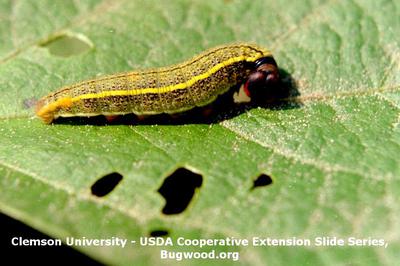Bean Leafroller
Urbanus proteus
Insect
In a Nutshell
- Feeding damage on leaves.
- Curled leaves.
Can also be found in
Symptoms
Larvae of the bean leafroller are defoliators. They cut a characteristic small triangular patch at the edge of the leaf, fold over the flap, and stay inside this shelter. They line their shelters with silk and leave them to feed on leaves at night.
Recommendations

Organic Control
If the population threshold is exceeded there can be damage to the plant. Predators of the bean leafroller are certain species of wasps and stink bugs, for example Polistes spp. wasps and Euthyrhynchus floridanus stink bugs. Sprays with pyrethrins also work against the bean leafroller.

Chemical Control
Always consider an integrated approach with preventive measures together with biological treatments if available. Apply insecticides to the foliage for effective leafroller suppression. This should be necessary only for late-season bean crops. Solutions containing pyrethroids can help to control populations.
What caused it?
Females lay up to 20 eggs (commonly in clusters of 2-6) underneath the leaves of the host plant. The eggs are creamy white to bluish-green in color and are hemispherical and measure about 1 mm in diameter. The larvae are green with a black dorsal line and two yellow stripes on each side. The head is brown or black and there is an orange or yellow spot on each side. The habitats of these butterflies include brushy fields and woodland edges. Their distribution is conditioned by the temperature. They are not found in high elevations or altitudes because they don’t survive prolonged freezing temperatures.
Preventive Measures
- Observe your field regularly and check the presence on leaf edges of folded triangular structures.
- Remove diseased leaves or plant parts.



